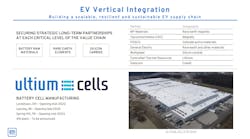So That Happened: Supply Chain Passion, NLRB Whiplash, Old School Cool
Editor’s note: Welcome to So That Happened, our editors’ takes on things going on in the manufacturing world that deserve some extra attention. This appears regularly in the Member’s Only section of the site.
GM Earnings: Check Out These Suppliers!
It used to be all about the cool. When General Motors reported earnings, if the numbers weren’t great, executives would talk about the cool new Chevy Corvette, cool new Cadillac CTS or cool new Pontiac Aztek waiting in the wings.
Whatever financial problems ailed the giant automaker, the solution was going to be cool new products that would ignite the passions of auto enthusiasts and get people into showrooms right away.
The company’s Q1 call last week, and Chair and CEO Mary Barra’s letter to investors announcing a solid $2.9 billion profit, was a little different. The cool new thing that’s going to invigorate the company’s future and ensure its relevance for decades to come? The supply chain!
With traditional automakers and startups all promising huge EV sales numbers within the decade, securing the right supply chain will be critical. At a recent conference in Ohio, Todd Dubner, KPMG’s U.S. lead for industrial manufacturing and automotive strategy, noted that if you total all the projections for sales by 2030, that figure exceeds the capacity to make EV batteries by a huge margin.
So, Barra’s focus on supplies makes sense, even if shiploads of lithium are less exciting than a growling V-8 in a Camaro. One of the slides in Barra’s presentation even brought back an ancient concept for a manufacturer that arguably drove the outsourcing craze of the ’80s and ’90s—vertical integration.
“These essential elements include rare earth materials, permanent magnets, Cathode Active Material and lithium, as well as a new cobalt agreement we announced this month. We are also in the process of securing long-term supply agreements for nickel, and we’ll have more to share as the year progresses,” Barra said.
You can practically hear the traction motors revving.
Thanks for a Job Well Done!
OK, I couldn’t resist. JobsOhio getting an award for doing a good job getting people jobs, is just too good to pass up.
JobsOhio, a private, nonprofit corporation that says it is “able to pursue economic development at the speed of business,” has seen a lot of success, and recently it was recognized for its accomplishments. In April the organization received the Gold Award, and was even the highest-scoring entry, in the 2022 American Business Awards Nonprofit Organization of the Year category.
"JobsOhio has been instrumental in driving growth and economic investment for Ohio, and (making) the case for a resurgence of manufacturing with surgical precision,” proclaimed one of the judges.
Since JobsOhio's creation in 2011, it has secured more than 3,300 project deals with commitments for more than 243,000 new jobs — $12 billion in new payroll.
And this year it struck gold when Intel Corp. agreed to a massive investment in the state. The company will invest a minimum of $20 billion to build two semiconductor manufacturing "fabs" in New Albany. The job count is 3,000 new, high-paying jobs with Intel, 7,000 construction jobs, and tens of thousands of support jobs.
Fun with the NLRB
In the past decade or so, there’s been a lot of whiplash around National Labor Relations Board rules. Decisions are recast, then blocked by the courts, then there’s a waiting period, and then a new U.S. presidential administration comes in and scuttles what came before. But Jennifer Abruzzo, general counsel for the NLRB appointed by President Joe Biden, is reaching much farther back for one particular rule change: 1969. That’s when the NLRB raised the bar sky-high for labor unions to win official recognition and head to the bargaining table with employers.
Before that year, unions were typically formally recognized after a majority of hourly employees signed union cards. But from 1969 to the present, employers have had much more power to question the union card-signing and force a formal election. And there’s usually a considerable wait for that election, which gives employers (if they are so inclined—and lately, Amazon, Starbucks, Tesla and others have been so inclined) plenty of time to denigrate/punish/fire pro-union workers and hold mandatory anti-union employee meetings during the workday, sometimes, multiple times a day and in violation of the law.
Abruzzo thinks that in most cases the card signing should be enough and the burden of proof is on employers to show that an election is necessary. She is pushing to reinstate a 1949 decision called the Joy Silk doctrine that would restrict employers’ ability to force an election and increase the penalties for unlawfully interfering with union organizing. A case against construction materials manufacturer Cemex, currently wending its way through the NLRB docket, could be the decision that removes considerable roadblocks for unions to organize. But if the rule is put in place, will it have staying power? (And by “staying” we don’t mean in limbo in the federal court system.) That’s the million-dollar question.
Feasting on Fatigue?
The narrative about recruiting talented technology workers to sectors viewed as less “sexy” has been strong since the earliest days of the Internet boom in the mid-1990s: “Old-school companies just can’t consistently compete with the shiny new adventures and perks on offer at blue-chip tech names, never mind exciting startups,” the lament goes.
But from the sound of it, the electrification of the automotive sector is changing that to some extent. Doug Field, chief EV and digital systems officer at Ford Motor Co.’s newly formed Model e group, said last week he has been “really delighted and surprised” by Ford’s ability to attract tech talent – in part, he said, precisely because of the company’s long history.
“I think there's a certain amount of fatigue in the tech world and a lot of mature products out there,” Field told analysts and investors on a conference call after Ford reported its first-quarter results. “The opportunity to work on high technology but do it in a brand that is so iconic in the United States and [on …] such a rich product like a vehicle is really attracting some great people.”
Field has a strong perspective on—and a solid link to—lots of talented people in tech: Since working as a development engineer at Ford from 1987 to 1993, he has spent time at Segway, Apple and Tesla, among other places. He helped launch Tesla’s Model 3 and worked on Apple’s automotive plans. When he rejoined Ford last year, he said “the staying power, the resources, the capabilities” of the blue oval were a big draw.
—Geert De LombaerdeAbout the Author
IW Staff
Find contact information for the IndustryWeek staff: Contact IndustryWeek

